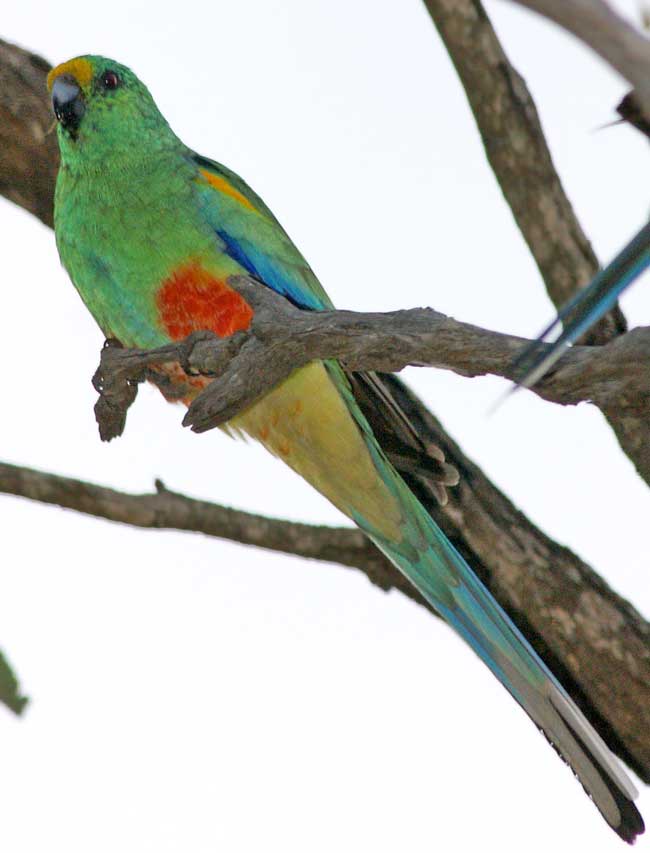
Psephotus varius (*)
Cladus: Eukaryota
Supergroup: Opisthokonta
Regnum: Animalia
Subregnum: Eumetazoa
Cladus: Bilateria
Cladus: Nephrozoa
Cladus: Deuterostomia
Phylum: Chordata
Subphylum: Vertebrata
Infraphylum: Gnathostomata
Superclassis: Tetrapoda
Classis: Aves
Subclassis: Carinatae
Infraclassis: Neornithes
Parvclassis: Neognathae
Ordo: Psittaciformes
Familia: Psittacidae
Subfamilia: Psittacinae
Tribus: Platycercini
Genus: Psephotus
Species: Psephotus varius
Name
Psephotus varius Clark, 1910
Vernacular name
Internationalization
Français: perruche multicolore
References
* Auk 27 p.80
The Mulga Parrot (Psephotus varius), also known as the Many-coloured Parrot, is endemic in arid scrublands and lightly timbered grasslands in the interior of southern Australia.[1]
Taxonomy
The Mulga Parrot was given its current scientific name of Psephotus varius by American zoologist Austin Hobart Clark in 1910, after its name Psephotus multicolor was ruled invalid as the original combination (Psittacus multicolor) had been used for another species.[2] It is one of five species in the Psephotus.
Common names include the Mulga Parrot, Many-coloured Parrot, and Varied Parrot.[3]
Description
The male Mulga Parrot is multicolored from which the common name Many-coloured Parrot of this species is derived. It is a bright green overall, with a bluish tinge on the neck and above the eye, and paler on the breast. The rump is light green. The forehead is yellow and there is a red patch on the back of the head. The lower belly and thighs are yellowish marked with orange-red and the wings greenish apart from the yellow median wing coverts and blue outer webs of primaries. The long tail is an assortment of colours: the two long central feathers are dark blue tinged with green, the outer feathers are blue shading to white and there is some red on the upper tail coverts. Its bill is a blue-grey edged with black, and iris is brown. The female is duller overall, with an olive-brown head and chest, duller yellow forehead and red patch on the back of the head, and pale green belly, and more brown-grey bill. It has a red shoulder.[1][3][4]
Distribution and habitat
The species ranges across the dryer interior of the Australian continent, from Western New South Wales from Collarenabri, West Wyalong and Griffith westwards through the northwestern tip of Victoria and across South Australia and into the dryer central regions of Western Australia west to the Wheatbelt and north to the Pilbara.[3] The Mulga Parrot is generally encountered in pairs in arid grassland and mulga scrubland.[4]
Breeding
Breeding season is anywhere from July to December or after rainfall, with one or occasionally two broods raised depending on rainfall. A hollow in a tree is utilised for nesting, and a clutch of four to six white eggs measuring 22 x 18 mm is laid there.[5]
References
1. ^ a b Stepnell, Kenneth; Boles, Walter. Australia's beautiful birds and their young. Sydney, Australia: Australian Consolidated Press. p. 66. ISBN 0949892130.
2. ^ "Species Psephotus (Psephotus) varius Clark, 1910". Australian Biological Resources Study: Australian Faunal Directory. Department of the Environment, Water, Heritage and the Arts, Australian Government. 9 October 2008. http://www.environment.gov.au/biodiversity/abrs/online-resources/fauna/afd/taxa/fc7df4b9-cb57-43ab-8908-d1ded3ea189f. Retrieved 30 April 2010.
3. ^ a b c Lendon, Alan H. (1973). Australian Parrots in Field and Aviary (2nd. ed). Sydney: Angus and Robertson. pp. 219–23. ISBN 0-207-12424-8.
4. ^ a b Forshaw, Joseph M. and Cooper, William T. (1978). Parrots of the World (2nd ed.). Melbourne: Landsdowne Editions. pp. 245–46. ISBN 0-7018-0690-7.
5. ^ Beruldsen, G (2003). Australian Birds: Their Nests and Eggs. Kenmore Hills, Qld: self. p. 250. ISBN 0-646-42798-9.
* BirdLife International (2009). Psephotus varius. In: IUCN 2009. IUCN Red List of Threatened Species. Downloaded on 30 April 2010.

